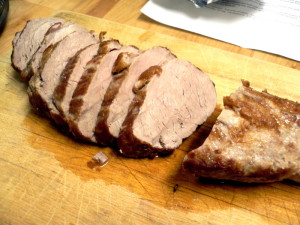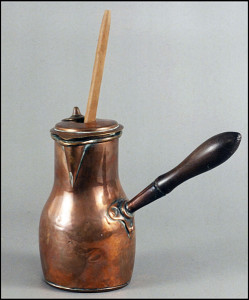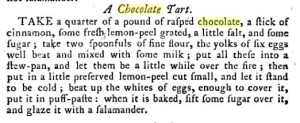In Listen to the Moon (my new Regency romance about a valet and a maid who marry to get a plum job), Toogood makes an onion pie.
“Are you fond of the Dymonds?” Sukey asked.
“Of course.” He said it without hesitation, and offered not a syllable more.
She shrugged and took a bite of her pie. Mmm. Roasted potatoes, sliced apples, hardboiled egg, onions and butter in a thick, rich dough. He really did know what he was about in the kitchen.
Several people have asked me if I have a recipe for this pie, and the answer is YES.
(Most of the foods mentioned in my books—Mr. Moon’s desserts, for example, although I took a little creative license with the bacon ice cream—are drawn from period sources and often from cookbooks, so if you do ever want a recipe, it’s worth asking!)
I took a Regency food class with Delilah Marvelle a few years ago, and one of the assignments was to cook something from a Regency recipe. I posted about the pie (plus a few other recipes I wasn’t as all about, although the potato cakes with sherry sauce for dessert were quite yummy too) on History Hoydens a few years ago, and here it is again for your delectation. The text of the original recipe comes first, and then my comments.
I took the recipe from Hannah Glasse’s The art of cookery, made plain and easy (1774). It’s actually a pretty straightforward cookbook compared to some others I’ve seen from the same era; her confectionery book, which I read for Sweet Disorder, is great too. (Although I’ve seen a food scholar complain that her recipes don’t always work.)
And read her Wikipedia page, it’s fascinating! (Sample: “In 1760 Ann Cook published Professed Cookery, which contained a 68-page attack on Hannah Glasse and her work. Ann Cook lived in Hexham, and was reacting to an alleged campaign of intimidation and persecution by [Hannah’s half-brother] Lancelot Allgood.”)
WASH and pare some potatoes, and cut them in slices, peel some onions, cut them in slices, pare some apples and slice them, make a good crust, cover your dish, lay a quarter of a pound of butter all over, take a quarter of an ounce of mace beat fine, a nutmeg grated, a tea-spoonful of beaten pepper, three tea-spoonfuls of salt, mix all together, strew some over the butter, lay a layer of potatoes, a layer of onion, a layer of apples, and a layer of eggs, and so on till you have filled your pye, strewing a little of the seasoning between each layer, and a quarter of a pound of butter in bits, and six spoonfuls of water. Close your pye and bake it an hour and a half. A pound of potatoes, a pound of onions, a pound of apples, and twelve eggs will do.
I wasn’t sure if “eggs” meant raw, or hard-boiled and crumbled. I asked Delilah, who said definitely hard-boiled, and that for a pie like this oftentimes the different filling ingredients would be cooked in advance to ensure even cooking. So I also sliced and roasted the potatoes on a cookie tray.
Mace is a spice derived from the dried covering of the nutmeg fruit seed; they didn’t sell any at my grocery store so I just used regular old nutmeg instead.
Here’s the crust recipe I used:
TO three pounds of flour rub in a pound and a half of butter, break in two eggs, and make it up with cold water.
Four cups of flour, two sticks of butter, and an egg would be plenty for a two-crust pie (I made a half-recipe even though in my heart I knew better and wound up with WAY too much dough). On Delilah’s advice I cooked the bottom crust alone for 15 minutes at 375 (actually, 400 because my oven runs cold, but whatever). I then put it in the fridge until it was cool, filled it up with my layers, rolled out the top crust, and baked it for about half an hour at 350 (you can tell when it’s done because the crust will start to turn golden; once it’s completely lost that doughy, translucent look, you’re done!).
The crust came out nice and flaky, and it was super easy to roll, too, maybe because of the egg. Next time I might chill the bottom crust before baking and then the whole pie once it’s assembled, to see if I can get just a little more flake, but it’s really not necessary. I halved the recommended amounts and still ended up with a lot of leftover filling stuff, I think next time I’ll start with one large potato, half a large apple, half a large onion, and four hard-boiled eggs. But I just made an egg-salad-potato-avocado sandwich with the leftovers the next day (so awesome, will eat again!). (I also used a lot less butter layered with the filling than recommended, probably only two to three tablespoons. I still enjoyed it but it would have been better, and cohered more, with more butter.)
At first I thought this was just okay (although my guests were enthusiastic), but when I tried it cold the following day, it was fantastic. The flavors and textures combined really well cold and overnight.
*
And a few more things about food and drink in Listen to the Moon:
A tumblr post I made about hot sauce in Regency England
Hannah Glasse’s recipe for calf’s foot jelly and Portugal cakes (I haven’t tested those)
Another tumblr post by me about cherry bounce, an infused Christmas brandy
This recipe is for Huckle-my-buff, a Sussex beer brandy and egg drink, served hot, which originally appeared in the book and now is mentioned only in this deleted scene on my blog where Sukey and Toogood have a threesome. (If that does not sound like your thing PLEASE DO NOT READ IT.)
Seedcake recipe
*
Tell me a combination of savory ingredients you think would taste delicious baked in a pie!

















